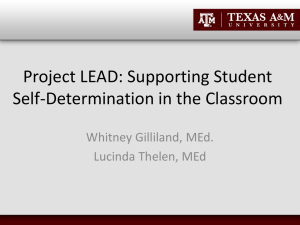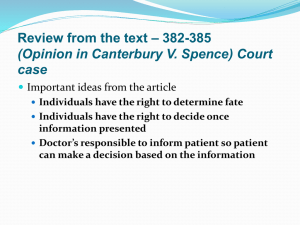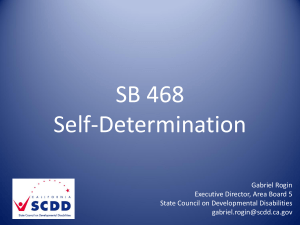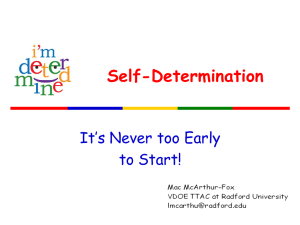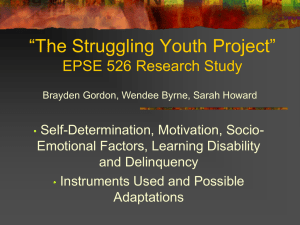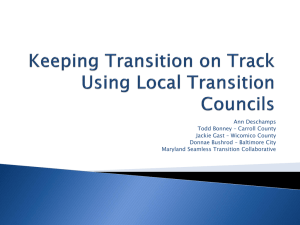File - Jeanine Lewis Portfolio
advertisement
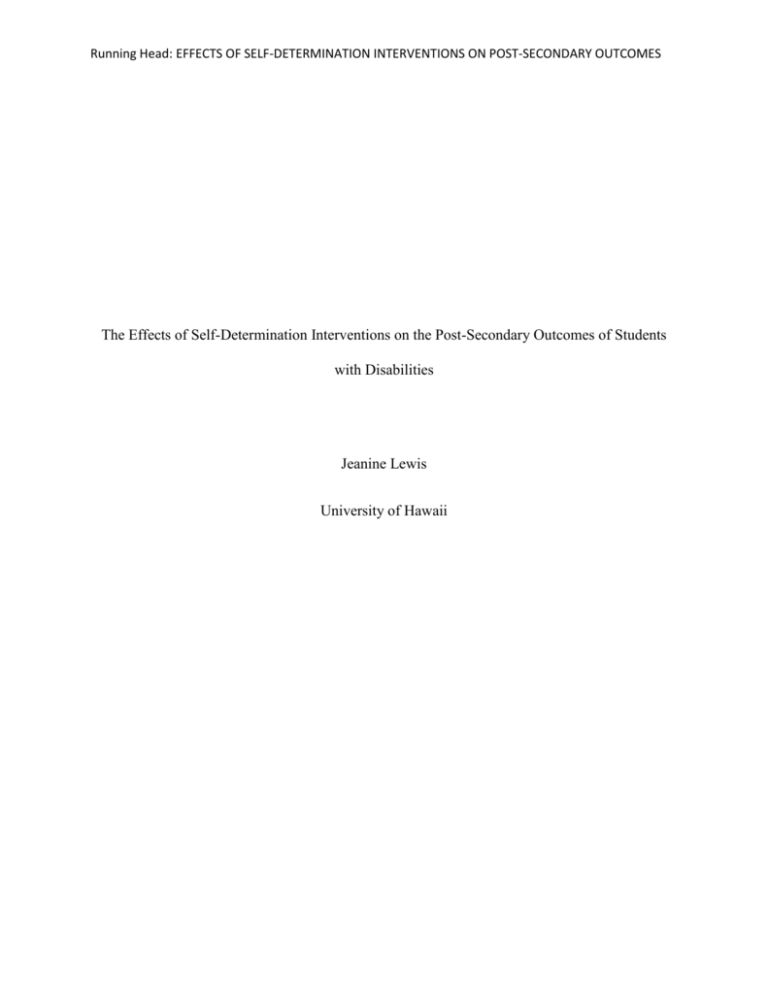
Running Head: EFFECTS OF SELF-DETERMINATION INTERVENTIONS ON POST-SECONDARY OUTCOMES The Effects of Self-Determination Interventions on the Post-Secondary Outcomes of Students with Disabilities Jeanine Lewis University of Hawaii EFFECTS OF SELF-DETERMINATION INTERVENTIONS ON POST-SECONDARY OUTCOMES Abstract Postsecondary education and training is an important step in the process of students with disabilities obtaining meaningful employment and being able to maintain a satisfactory quality of life. Now more than ever, students with disabilities are entering higher education. Unfortunately, the completion rates for these students remain low. One possible reason for this is that many students with disabilities lack the self-determination skills that are necessary for success in postsecondary education and ultimately the workplace. This literature review examines the impact that interventions that promote self-determination during the transition process have on student outcomes in a post-secondary environment. Keywords: self-determination, transition, disability, post-secondary outcomes, vocational rehabilitation, person centered planning, behavioral self-management and emotional and behavioral disorders. 2 EFFECTS OF SELF-DETERMINATION INTERVENTIONS ON POST-SECONDARY OUTCOMES The Effects of Self-Determination Interventions on the Post-Secondary Outcomes of Students with Disabilities The purpose of transition services is to ensure students’ who have an Individualized Education Plan (IEP) are adequately prepared for post-secondary education, employment, and independent living. Federal regulations for providing transition services were included in the Individuals With Disabilities Act of 2004 (IDEA, 2004) and should be in place by the time a student is 16 years old (Landmark, Ju, & Zhang, 2010). While regulations serve to reinforce the development of transition plans for students with disabilities, disparities exist among the postsecondary outcomes between these students and their non-disabled peers. For example, students with disabilities are more likely than their non-disabled peers to experience difficulty in one or more of the following four skill areas, including: (a) social skills; (b) career/vocational skills; (c) academic skills; and (d) independent living skills (Scanlon, Patton, & Raskin, 2011). Research indicates that transition services are effective for improving the post-secondary outcomes of students with disabilities (Newman et al., 2011; Wagner, Newman, Cameto, & Levine, 2005). Nonetheless, the gap for students with disabilities persists. According to a report from the National Longitudinal Transition Study-2 (Newman et al., 2011) young adults with disabilities were less likely to have enrolled in postsecondary programs than were their non-disabled peers (60 % vs. 67 %). In addition, the postsecondary completion rates of students with disabilities were lower than those of similar-aged students without disabilities (41% vs. 52%). Furthermore, students with disabilities also lag behind their peers with respect to employment. According to the US Department of Labor Office of Disability Employment Policy, "Persons with a Disability: Labor Force Characteristics Summary" (2012), only 20.9 % of people with disabilities participated in the workforce, as compared to 69.4 % for 3 EFFECTS OF SELF-DETERMINATION INTERVENTIONS ON POST-SECONDARY OUTCOMES people without disabilities. Finally, the unemployment rate for people with disabilities was 13.9%, as compared to 8.0% for those without disabilities. An effective means of addressing the gap for students with disabilities is to develop transition plans that include developing selfdetermination skills. Self-determination is defined as the combination of skills, knowledge, and beliefs that enable a person to engage in goal-directed, self-regulated, autonomous behavior (Algozzine, Browder, Karvonen, Test, & Wood, 2001). Self-determination reflects the belief that all individuals, including those with disabilities, have the right to make choices regarding their own lives. Teaching and promoting these skills within the provisions of transition services for youth with disabilities has become an expectation of the federal government with the reauthorizations of IDEA in 2004 and the Americans with Disabilities Act in 2009. Direct instruction in selfdetermination has been identified as a best practice in the field of special education and has also been identified as an essential component of a student's transition plan (Test et al., 2009). This includes embedding self-determination instruction within transition services. A large body of research indicates that self-determination contributes to individuals with disabilities successfully transitioning from high school to post-secondary environments (Field, Sarver & Shaw, 2003; Halpern, Yovanoff, Doren, & Benz, 1995; Konrad, Fowler, Walker, Test, & Wood 2007; Wehmyer & Schwartz, 1997, 1998; ). The Path Analytic Study, conducted by Solberg, Howard, Gresham & Carter (2012), found that involvement in quality learning environments and individualized planning are strongly associated with developing an array of valuable skills and dispositions that can enhance student self-determination and preparation for adulthood. Also, research on the personal attributes of successful adults with disabilities indicates that strong academic skills (Benz,Yovanoff, & Doren, 1997; Halpern, Yovanoff, Doren, & Benz, 1995) and 4 EFFECTS OF SELF-DETERMINATION INTERVENTIONS ON POST-SECONDARY OUTCOMES high levels of self-determination (Wehmeyer & Palmer, 2003; Wehmeyer & Schwartz, 1997, 1998) are correlated with improved post-secondary outcomes. Self-determination is not achieved simply because an individual has certain requisite knowledge and skills; it is also important that key people and institutions in the person’s life provide a context conducive to selfdetermination (Bremer, Kachgal & Schoeller, 2003). Abery and Stancliffe (1996) have noted that even when youth have excellent self-determination skills, they can be thwarted in their efforts to become self-determined by people and institutions that present barriers or fail to provide needed supports. Multiple studies indicate that self-determination status is a predictor of quality of life for individuals with disabilities and is positively correlated with improved employment, independent living, and community inclusion outcomes (Lachapelle, et al., 2005; Nota, Ferrari, Soresi, & Wehmeyer, 2007; Wehmeyer et al., 2005). Students may lack opportunities to act independently and make decisions for themselves. This may result in less experience in self-advocacy, which is an important component of self-determination. Because of these limitations, students may not be successful in negotiating the daily challenges that they will experience in post-secondary education and the workplace. Wehmeyer and Palmer (2003) conducted studies of students with disabilities one and three years after they left school to examine how they were doing in three major life categories: employment, independent living, and community integration. The results of these studies indicated that students who were more self-determined fared better across the three major life categories. Teaching self-determination skills is important, but also working collaboratively with schools, vocational rehabilitation, and community based agencies is necessary in order to provide the supports needed to enhance quality of life and post-secondary outcomes for students with disabilities 5 EFFECTS OF SELF-DETERMINATION INTERVENTIONS ON POST-SECONDARY OUTCOMES Vocational Rehabilitation In her statement before the Committee on Health, Education, Labor and Pensions at the United States Senate, Commissioner Sharon Lewis of the Administration on Developmental Disabilities, US Department of Health and Human Services stated, For people with intellectual and developmental disabilities, self-determination is another important factor in employment outcomes. Individuals with ID/DD [intellectual disabilities/developmental disabilities] who have the degree of control they desire over their lives consistent with their capacities, strengths and needs are more likely to express satisfaction with their individual employment outcomes" (Lewis Testimony, US Senate, 2011). There is a growing body of evidence in the field of vocational rehabilitation that, in particular, enhancing choice opportunities for clients leads to better vocational rehabilitationrelated outcomes. For example, Farley, Bolton, and Parkerson (1992) evaluated the impact of strategies to enhance consumer choice and involvement in the vocational rehabilitation process, and found that consumers who were actively involved in vocational rehabilitation planning enhanced vocational career development outcomes. In the book Real Work for Real Pay by Wehman, Brooke and Inge (2007), one of the major barriers in the area of unemployment for people with disabilities is their lifelong inexperience of gaining control over the major events in their lives (Izzo & Lamb, 2003). Oftentimes, people with disabilities are not offered the opportunity to make decisions for themselves. They are the recipients of others' choices for them. Because of this they often lack the self-confidence to decide what they want to do as opposed to just doing what others choose for them, which in turn does not allow for enhanced self-determination. Izzo and Lamb (2003) also stated that given that only 29% of people with 6 EFFECTS OF SELF-DETERMINATION INTERVENTIONS ON POST-SECONDARY OUTCOMES disabilities ages 18-64 are employed, it is not unreasonable to assume that a lack of selfdetermination skills contributes to these poor employment outcomes. Informed choice, consumer empowerment and other values related to self-determination are addressed in rehabilitation legislation and rehabilitation education programs, but these topics have not been widely studied in the rehabilitation literature (Thoma & Sax 2003). However, there is compelling evidence from the special education literature that enhanced self-determination leads to more positive adult outcomes (Wehmeyer, 2003). In the late 1990’s there was a growing mindfulness in the fields of disability services, rehabilitation, education, and psychology of the need to promote self-determination for individuals with mental retardation and developmental disabilities (Wehmeyer & Schwartz, 1998). The role of vocational rehabilitation in the transition process is to allow students to have more opportunities for choice. In their study on career development needs of college students, Hitchings, Luzzo, Risto, Horvath, Retish, and Tanners (2001) found that a major attribute of highly successful adults with disabilities was their sense of control over career-related events and a conscious decision to take charge of one's life. The 1998 amendments to the State Vocational Rehabilitation Services Program Act states that disability is a natural part of the human experience and in no way diminishes the right of individuals to: (a) live independently; (b) enjoy self-determination; (c) make choices; (d) contribute to society; (e) pursue meaningful careers; and (f) enjoy full inclusion and integration in the economic, political, social, cultural and educational mainstream of American society (Wehmeyer, 2003). Not only are self- determination and choice included in federal mandates (as indicated above), but according to Wehmeyer and Palmer (2003), “students who were more selfdetermined fared better across multiple life categories, including employment and the access to health and other benefits” (p. 131). It is imperative that vocational rehabilitation services 7 EFFECTS OF SELF-DETERMINATION INTERVENTIONS ON POST-SECONDARY OUTCOMES coupled with education and community-based programs provide adequate opportunity for students with disabilities to transition into the community and become viable, self-determined individuals with the ability to enjoy the personal fulfillment and self-sufficiency that their nondisabled peers enjoy. Despite consensus on the significance of self determination as part of the transition process, the research and practice knowledge bases on its functions and how best to promote it are lacking (Scanlon, Patton, & Raskin 2011). Evidence demonstrates academic skills developed in conjunction with self-determination skills promote more positive outcomes for students with disabilities. Instruction in fundamental self-determination skills (e.g., goal-setting, self management) actually promotes academic skill development (Fowler, Konrad, Walker, Test, & Wood, 2007; Konrad, Treia, & Test, 2006). School programs should not only emphasize academic skills development, but also self-determination development as well. Terminology For the purposes of this literature review, self-determination as defined by Deci & Ryan will be used which states, that human motivation requires an innate psychological need for competence, autonomy, and relatedness (2000, 2008). The social contexts that support these basic needs allow for a growth process that fosters intrinsic motivation, which in turn allows for goal attainment and satisfaction with personal well being. Post-secondary outcomes are defined according to Indicator 14 of IDEA, which is: Outcomes for youth who had individualized education programs (IEPs) are no longer in secondary school and who have been competitively employed, enrolled in some type of postsecondary school, or both, within one year of leaving high school (U.S.C.1416(a)(3)(B)). 8 EFFECTS OF SELF-DETERMINATION INTERVENTIONS ON POST-SECONDARY OUTCOMES Transition services are defined in IDEA as: A coordinated set of activities for a child with a disability that-- (a) is designed to be a results-oriented process, that is focused on improving the academic and functional achievement of the child with a disability to facilitate the child's movement from school to post-school activities, including post-secondary education, vocational education, integrated employment (including supported employment), continuing and adult education, adult services, independent living, or community participation; (b) is based on the individual child’s needs, taking into account the child's strengths, preferences, and interests . 34 CFR §§300.43 and 300.320(b). According to the US Department of Human Services (2012), vocational rehabilitation is a program that provides individualized vocational rehabilitation and supportive services to assist eligible individuals with disabilities to get and keep jobs compatible with their skills and abilities. Because of the disparity between the mandates that require students with disabilities who receive transition services that include self-determination and the apparent lack of selfdetermination skills being demonstrated by students in post-secondary environments, my research question is: What is the impact of interventions that teach self-determination skills on students with disabilities in a postsecondary environment? The purpose of this analytical literature review is to examine the research to determine the impact that interventions that promote self-determination have on student outcomes in a post-secondary environment and synthesize the findings in order to address this disparity by providing insight into what can be done to better serve this student population. 9 EFFECTS OF SELF-DETERMINATION INTERVENTIONS ON POST-SECONDARY OUTCOMES Methodology Search Process For this literature review an electronic search was conducted using EBSCOhost, Academic Search Premier, Professional Development Collection and ERIC. I also completed a manual search of articles in Career Development for Exceptional Individuals, which was not available to me at the time in an online format. A search of references of all articles that were collected and previous literature reviews on self-determination, person centered planning and transition was also completed. Key words identified for the online search are as follows: selfdetermination, transition, disability, post-secondary outcomes, vocational rehabilitation, person centered planning, behavioral self-management and emotional and behavioral disorders. Criteria for Selection In this review all participants included were required to have at least one identified disability according to IDEA or the Americans with Disabilities Act or be identified by agencies that provide services as having a disability. Studies that do not identify a disability status will be excluded. Studies included participants who were in a transition program or a post secondary environment, in a job training program, community college, 4-year college, unemployed or currently employed in any capacity paid or volunteer. Included are studies that demonstrate the use of interventions that include at least one component of self-determination. Excluded are those studies that do not address any component of self-determination. Both qualitative and quantitative measures of outcomes will be included in this review. Anecdotal information and articles that do not contain empirical research are excluded from this review. The studies reviewed were published between the dates of January 2000 and March 2012. Peer reviewed journals as well as dissertations were reviewed. 10 EFFECTS OF SELF-DETERMINATION INTERVENTIONS ON POST-SECONDARY OUTCOMES Results Student Demographic Information 1624 students were included in the eight studies, with a range of 6-954 participants. Two studies included students who were below age 18, but also served students who were between the ages of 18-21, which allowed for inclusion. There were 1049 (61.9%) male and 635 (39.1%) female participants. Only four studies listed the ethnicity of the participants. Of those four studies 77% (1207) were Caucasian, 11% (156) Hispanic, 6% (109) African American and 5% (93) were listed as other. Disability categories were listed for each of the 8 studies analyzed for this review. Participants fell into one or more of 5 categories: Learning Disability, 49% (823), Mental Retardation, 15% (252), Emotional Behavioral Disturbance, 11% (187), Physical Disability, 1% (21), and other, 22% (371). Setting Of the eight studies examined, five interventions occurred in a post-secondary environment in both job related and academic settings. In three studies the intervention occurred in a secondary environment and the data were then subsequently collected and analyzed in a post-secondary setting. Six studies were conducted within one state and two studies used multiple states to collect data. Geographically, the states represented all quadrants of the US mainland, excluding Alaska. In order to be included in this literature review, the independent variable had to include at least one component of self-determination. The components of self-determination that were included are goal setting, personal choice, person centered planning regarding employment, independent living skills, self-directed planning, self-advocacy, internal locus of control, autonomy, self-regulation, psychological empowerment, and self-realization. 11 EFFECTS OF SELF-DETERMINATION INTERVENTIONS ON POST-SECONDARY OUTCOMES Experimental Design Quantitative, qualitative and mixed method research designs were all used for the studies included in this literature review. One study ( Jameson, 2007) used a two-phase process utilizing both qualitative and quantitative methods. For the quantitative portion of the study a survey and the ARC Self-Determination Scale (Weymeyer & Ketchner, 1995), which is a 72 item self-report scale that measures with points the level of perceived self-determination within the four domains of autonomy, self-regulation, empowerment and self-realization, were mailed to the participants. Jameson then followed up with the qualitative portion of the study and interviewed all participants in order to further explore and give voice to the participants. All of the other studies examined used quantitative methods to analyze the findings. The group size varied widely between the studies. The largest group had 956 participants and the smallest group had 6 participants. All of the studies reported gains in self-determination post intervention. Of the eight studies examined in this literature review, four used an adaptation of the Self-Determined Learning Model of Instruction (Wehmeyer, Palmer, Agran, Mithaug, & Martin, 2000). In each of these four studies, the Self-Determined Learning Model of Instruction was used on different student populations and in different settings. For example, Wehmeyer et al., (2003) adapted this model to accommodate a small study of 6 adults in order to examine career development and Wehmeyer, Palmer, Lee, Williams-Diehm, & Shogren (2011), also adapted this model to study 493 participants who ranged in age from 11-21 in order to examine the impact of the intervention "Whose Future is it Anyway?" on transition knowledge and skills. Information was collected about participants' levels of self-determination using The Arc's Self-Determination Scale (Wehmeyer & Ketchner, 1995) in four of the eight studies. Other methods used to measure selfdetermination were, the Autonomous Functioning Checklist (Sigafoos, Feinstein, Diamond, & 12 EFFECTS OF SELF-DETERMINATION INTERVENTIONS ON POST-SECONDARY OUTCOMES Reiss, 1988), Goal Attainment Scale (Kiresuk & Lund, 1976), the How I Feel About Myself Scale (Rehfeldt, 2006) and the Adult Hope Scale (Snyder, Harris, Anderson, Holleran, Irving, Sigmon, et al., 1991). Domains of Self-Determination According to the ARC Self-Determination Scale (Wehmeyer & Kelchner, 1995), the essential characteristics that make up self-determination are autonomy, which involves the degree of independence that a person exercises on the basis of personal beliefs, values, and interests; self-regulation, which is composed of interpersonal cognitive problem solving, goal setting and attainment, and task performance; psychological empowerment, which measures locus of control; and self-realization which is the ability to understand one’s strengths and weaknesses and the ability to use these attributes to positively influence quality of life. There are many characteristics that make up sub-domains, which fall under these major categories. Each of the studies examined looked at more than one characteristic that makes up self-determination. Because all of these studies focused on transition and post-secondary outcomes they all measured goal setting and attainment, decision-making, and independent living behaviors. Only one study looked at self-determination within a social construct. All studies had an academic skills component as well as a vocational component. 13 Running Head: EFFECTS OF SELF-DETERMINATION INTERVENTIONS ON POST-SECONDARY OUTCOMES TABLE 1 Summary of Literature of the Effects of Self-Determination Interventions Study Agran & Wehmeyer (2000) Intervention Sample Method Self-Determined Learning Model of Instruction 19 students categorized as having a disability and served through special education services. 12 students were male and 7 were female. . Quantitative single case Delayed multiple baseline across groups Outcomes 89% of student goals were at or above the expected level of outcome as rated by their teachers. 3 Groups Benz, Lindstrom & Latta (1999) Youth Transition Program Jameson (2007) Learning Center Basic Skills Assessments 956 Students receiving transition services through local school districts and state vocational rehabilitation services. 601 male and 355 female. 48 community college students who formally or informally Baseline Phase Training Phase Post-training Phase Quantitative Descriptive Mixed Methods 90% high school completion. 82% secured competitive employment, postsecondary education or combination at program exit. 80% maintained a rate of employment or education consistently for 2 years after program. This mixed methods study found that the EFFECTS OF SELF-DETERMINATION INTERVENTIONS ON POST-SECONDARY OUTCOMES disclosed a physical, emotional or learning disability. Karpur, Clark, Caproni & Sterner (2005) Steps-to-Success 68 students who had at least one year of program exposure. Morningstar, et al. (2010) Family Role and 76 students attending 2 or 4-year Transition Programming colleges who had an IEP in high school. students with lower selfQuantitative determination described Descriptive more negative postsecondary outcomes. Qualitative The students with higher Phenomonology self-determination Interviewing described more positive post secondary outcomes Quantitative Intervention group 41.9% employed. NonDescriptive Intervention group 50.6% employed, unexpected result. Postsecondary education I group 27.9% non-I group 8.7 statistically significant. Incarceration rate: I group 2.8% non-I group 11.6%. I group 3 times more likely to continue education as compared with non-I group. Quantitative School-based transition services and family Descriptive involvement. 3 dimensions of selfdetermination used revealed strong correlations between hope and psychological empowerment, hope and 15 EFFECTS OF SELF-DETERMINATION INTERVENTIONS ON POST-SECONDARY OUTCOMES Wehmeyer, et al. (2003) Self-Determined Career Development Model 6 Adults receiving vocational rehabilitation services Single case design Multiple Baseline across 3 pairs locus of control, and psychological empowerment and locus of control Range in mean increased responses 0%45%. Overall mean increase from baseline to treatment was 25%. Nonparametric tests and visual analysis Wehmeyer, et al. (2006) Beyond High School 15 Students 18-21 years. 8 male 7 female. Quantitative Descriptive Pre-Post Wehmeyer, et al. (2011) Whose Future is it Anyway? 493 students receiving SPED services across multiple disability categories in 6 states. Scores from 40-60 in line with acceptable performance. Mean score of 51.5. 5% below 40. 60% above 50 & 35% above 60. Quantitative 2 measures of selfdetermination, SDS and Experimental AIR. Students in intervention group Randomly showed gains in both assigned control measures, but showed and treatment significantly more group positive results for AIR than control group. 16 Running Head: EFFECTS OF SELF-DETERMINATION INTERVENTIONS ON POST-SECONDARY OUTCOMES Discussion The findings from this literature review indicate that teaching self-determination skills is beneficial for successful post-secondary outcomes for students with disabilities. Hitchings et al., reported that a major attribute of highly successful adults with disabilities is a "strong sense of control over career-related events and a conscious decision to take charge of their lives" (p. 9). This statement is consistent with the findings of this literature review. Overall, the students who participated in the studies reviewed all had higher levels of ability in regards to the decisionmaking process post intervention, as demonstrated by, Wehmeyer, et al. (2006), in their Beyond High School intervention. Students scored significantly higher on decision-making skills postintervention. The Self-Determined Learning Model of Instruction has been studied in various environments with different student populations. This model appears to be a very valuable model of instruction for teaching self-determination skills to students with disabilities based on empirical research. Gaps in the Literature In this literature review the Self-Determined Learning Model of Instruction was used in four of the nine studies. The model was studied across various populations examining different aspects of self-determination. Although this is very valuable research indicating positive effects through replication across multiple populations, it would also be beneficial to study other interventions as intensely in order to offer variation in relation to programs offered and empirical research. Self-determination is a complex construct that is comprised of a broad range of skills (Konrad, et al., 2007). Because of this, it is difficult to determine exactly which selfdetermination skills result in positive outcomes and whether it is the attainment of selfdetermination skills or maturation on the part of the students that is the causal agent. Although EFFECTS OF SELF-DETERMINATION INTERVENTIONS ON POST-SECONDARY OUTCOMES research indicates that there is a correlation between self-determination and positive postsecondary outcomes it is difficult to say that the intervention itself was a causal agent. Because of the ever-changing quality of life situations that students with disabilities face on any given day it is difficult to ascertain whether the self-determination intervention was actually the impetus of the gain or whether life-changing events caused the more positive outcomes. Recommendations for Future Research Only one study in this review looked at the social aspects of self-determination. Because communication skills and the ability to assimilate into a social or work environment is critical to autonomy, it would be beneficial to study how teaching social skills affects self-determination and success in a post-secondary environment. Also, more varied models, based on different combinations of self-determination skills and the different needs of individual students, such as more culturally responsive curricula for culturally and linguistically diverse students with disabilities, should be developed in order to study what works best with different disabilities and different levels of autonomy, self-regulation, psychological empowerment, an self-realization. Experimental studies to pinpoint exactly what interventions work with the individual needs of students would be beneficial in order to provide the individualized services that students need in order to become successful in post-secondary environments. This in turn would allow teachers providing transition services, vocational rehabilitation counselors, faculty and staff at two and four year educational institutions, and service providers in the community the ability to more effectively provide students with disabilities the opportunities to lead a more productive, fulfilling lives in the community to the best of their abilities. 18 EFFECTS OF SELF-DETERMINATION INTERVENTIONS ON POST-SECONDARY OUTCOMES References Abery, B. & Stancliffe, R. (1996). The ecology of self-determination. In D. J. Sands & M. L. Wehmeyer (Eds.), Self-determination across the life span: Independence and choice for people with disabilities (pp.111-146). Baltimore: Paul H. Brookes. Agran, M., & Wehmeyer, M. (2000). Promoting transition goals and self-determination through student self-directed learning: The self-determined learning model of instruction. Education and Training in Mental Retardation and Developmental Disabilities 35(4) 351-364. Algozzine, B., Browder, D., Karvonen, M., Test, D., & Wood, W. (2001, Summer). Effects of interventions to promote self-determination for individuals with disabilities. Review of Educational Research, 71(2), 219-277. Baer, R., Flexer, R., Beck, S., Amustutz, N., Hoffman, L., Brothers, J., Stelzman, D., & Zechman, C. (2003). A collaborative follow-up study on transition service utilization and post-school outcomes. Career Development for Exceptional Individuals 26(1), 7-25. doi: 10.1177/088572880302600102 Benz, M., & Lindstrom, L. (1999). Improving collaboration between schools and vocational rehabilitation: The youth transition program model. Journal of Vocational Rehabilitation 13, 55-63. Bremer, C., Kachgal, M., & Schoeller, K. (2003, April). Improving secondary education and transition services through research. National Center on Secondary Education and Transition Research to Practice Brief (2)1. Deci, E. L., & Ryan, R. M. (2000). The “what” and “why” of goal pursuits: Human needs and the self-determination of behavior. Psychological Inquiry, 11, 227-268. Deci, E. L., & Ryan, R. M. (2008). Facilitating optimal motivation and psychological well-being 19 EFFECTS OF SELF-DETERMINATION INTERVENTIONS ON POST-SECONDARY OUTCOMES across life's domains. Canadian Psychology/Psychologie Canadienne, 49, 14-23. Farley, R., Bolton, P., & Parkerson, R. (1992). Effects of client involvement in assessment on vocational development. Rehabilitation Counseling Bulletin 35(3), 146-153. Gagné, M., & Deci, E., (2005). Self-determination theory and work motivation. Journal of Organizational Behavior 26(4) 331-362. Hitchings, W. E., Luzzo, D. A., Ristow, R., Horvath, M., Retish, P., & Tanners, A. (2001). The career development needs of college students with learning disabilities: In their own words. Learning Disabilities Research & Practice, 16(1), 8-17. Izzo, M., & Lamb, P. (2003). Developing self-determination through career development activities: Implications for vocational rehabilitation counselors. Journal of Vocational Rehabilitation 19 71-78. Jameson, D. (2007). Self-determination and success outcomes of two-year college students with disabilities. Journal of College Reading and Learning 37(2). Karpur, A., Clark, H., Caproni, P., & Sterner, H. (2005). Transition to adult roles for students with emotional/behavioral disturbances: A follow-up study of student exiters from stepsto-success. Career Development for Exceptional Individuals 28(1), 36-46. Kiresuk, T. J., & Lund, S. H. (1978). Goal attainment scaling: Research evaluation and utilization. In H. C. Schulberg & F. Baker (Eds.), Program evaluation in the health fields: Vol. 2. (pp. 21-45). New York: Behavioral Publications. Konrad, M., Fowler, C., Walker, A., Test, D., & Wood, W. (2007). Effects of selfdetermination interventions on the academic skills of students with learning disabilities. Learning Disability Quarterly, 30(spring), 89-113. Lachappelle Y., Wehmeyer M., Haelewyck M., Courbois Y., Keith K., Schalock R., 20 EFFECTS OF SELF-DETERMINATION INTERVENTIONS ON POST-SECONDARY OUTCOMES Verdugo, M., & Walsh, P. (2005). The relationship between quality of life and selfdetermination: An international study. Journal of Intellectual Disability Research (49)10. 740-744. Moen, T. (2006). Reflections on the narrative research approach. International Journal of Qualitative Methodology, 5(4). Morningstar, M., Frey, B., Noonan, P., Ng, J., Clavenna-Deane, B., Graves, P., Kellems, R., McCall, Z., Pearson, M., Wade, D., Williams-Diehm, K. (2010). A preliminary investigation of the relationship of transition preparation and self-determination for students with disabilities in post-secondary educational settings. Career Development for Exceptional Individuals 33(2), 80-94. Nota, L., Ferrari, L., Soresi, S., & Wehmeyer, M. (2007). Self‐ determination, social abilities and the quality of life of people with intellectual disability. Journal of Intellectual Disability Research, 51(11), 850-865. Newman, L., Wagner, M., Huang, T., Shaver, D., Knokey, A.-M., Yu, J., Contreras, E., Ferguson, K., Greene, S., Nagle, K., & Cameto, R. (2011). Secondary school programs and performance of students with disabilities: A special topic report of findings. National Longitudinal Transition Study-2 (NLTS2) (NCSER 2012-3000). U.S. Department of Education. Washington, DC: National Center for Special Education Research. Available at www.nlts2.org/reports/2011_11/nlts2_report_2011_11_complete.pdf Powers, L., Garner, T., Valnes, B., Squire, P., & Turner, A. (2007). Building a successful adult life: Findings from youth-directed research. Exceptionality, 15(1), 45–56. 21 EFFECTS OF SELF-DETERMINATION INTERVENTIONS ON POST-SECONDARY OUTCOMES Rehfeldt, J. (2006). An investigation into the effects of using the Transition Planning inventory on IEP goal development and locus of control. Dissertation Abstracts International, 68(01). AAT No. 3251347). Scanlon, D., Patton, J., & Raskind, M. (2011). Transition to daily living for persons with high incidence disabilities. In J. M. Kauffman & D. P. Hallahan (Eds.), Handbook of Special Education (pp.594-607). New York: Routledge. Sigafoos, A. D., Feinstein, C. B., Damond, M., & Reiss, D. (1988). The measurement of behavioral autonomy in adolescence: The Autonomous Functioning Checklist. In C. B. Feinstein, A. Esman, J. Looney, G. Orvin, J. Schimel, A. Schwartzberg, et al. (Eds.), Adolescent psychiatry (Vol. 15. pp. 432-462). Chicago: University of Chicago Press. Thoma, C., & Sax, C. (2003). Self-determination: What do rehabilitation counseling students know and where do they learn it? Journal of Vocational Rehabilitation, 19(2), 89-94. Wagner, M., Newman, L., Cameto, R., & Levine, P. (2005). Changes over Time in the Early Postschool Outcomes of Youth with Disabilities. A Report of Findings from the National Longitudinal Transition Study (NLTS) and the National Longitudinal Transition Study-2 (NLTS2). Online Submission. Wehmeyer, M. & Kelchner, L. (1995). ARC self- determination scale. Arlington, TX: The Arc of the United States. Wehmeyer, M., & Schwartz, M. (1998). The Relationship between Self-Determination and Quality of Life for Adults with Mental Retardation. Education and Training in Mental Retardation and Developmental Disabilities, 33, 3-12. 22 EFFECTS OF SELF-DETERMINATION INTERVENTIONS ON POST-SECONDARY OUTCOMES Wehmeyer, M., Palmer, S., Agran, M., Mithaug, D., & Martin, J. (2000). Promoting causal agency: The self-determined learning model of instruction. Exceptional Children 66(4), 439-453. Wehmeyer, M. & Palmer, S. (2003). Adult outcomes for students with cognitive disabilities three-years after high school: The impact of self-determination. Education and Training in Developmental Disabilities, 38(2), 131-144. Wehmeyer, M., Lattimore, J., Jorgensen, J., Palmer, S., Thompson, E., & Schumaker, K. (2003). The self-determined career development model: A pilot study. Journal of Vocational Rehabilitation 19, 79-87. Wehmeyer, M., Garner, N., Yeager, D., & Lawrence, M. (2006). Infusing self-determination into 18-21 services for students with intellectual or developmental disabilities: A multistage, multiple component model. Education and Training in Developmental Disabilities, 41(1), 3-13. Wehmeyer, M., Palmer, S., Lee, Y., Williams-Diehm, K., & Shogren, K. (2011). A randomized trial evaluation of the effect of whose future is it anyway? on self-determination. Career Development for Exceptional Individuals, 34(1), 45-56. Wehmeyer, M., Shogren, K., Palmer, S., Williams-Deihm, K., Little, T., & Boulton, A. (2012). The impact of the self-determined learning model of instruction on student selfdetermination. Exceptional Children, 78(2), 135-153. 23
